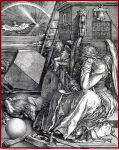Ann E. Michael's Blog, page 59
March 19, 2015
Dogs & lions
By chance, I encountered the poem “Thorn Leaves in March” by W.S. Merwin (1956, Poetry magazine) a day ago and felt levels of resonance such as poems can evoke. The powerfully “clear expression of mixed feelings”–thank you again, W.H. Auden–converges with seasonal details in this early Merwin piece and merges, completely by happenstance, with events in my current life.
Walking out in the late March midnight
With the old blind bitch on her bedtime errand
Of ease stumbling beside me, I saw
At the hill’s edge, by the blue flooding
Of the arc lamps, and the moon’s suffused presence…
My elderly dog stumbles beside me on these late-winter nights; I do not think she will see another full-blooming spring. Resonance.

Rescue of an orphaned lamb.
“As a white lamb the month’s entrance had been…” Well, that has certainly been true of this year’s weather. And the lamb allusion makes me think not just of the old saying about March but about my daughter, who is spending this month’s last two weeks working among ewes on a farm in Scotland as lambing season progresses.
Merwin’s speaker refutes the aphorism; his March comes in like a lamb because it is white, and goes out in white, as well:
…as a lamb, I could see now, it would go,
Breathless, into its own ghostliness,
Taking with it more than its tepid moon.
The lion, he claims, is “The beast of gold, and sought as an answer,/Whose pure sign no solution is.” No lion in this quiet, late-winter/cusp-of-spring snowfall–the light is silvery, the budding leaves of the thorn trees translucent and cold. The speaker stands beneath the “sinking moon” and wonders, questions, listening for something he knows he will not hear.
The old dog, domestic companion (neither lion nor lamb), completes her mission; the man lets go of metaphysical thoughts; the earth inexorably turns toward summer–despite the snow.
I’ll keep this poem in mind as the next snowstorm heads my way on the equinox.

March 14, 2015
Roadkill
As the spring equinox approaches and creatures rouse from dormancy, the number of roadkill incidents spikes. Yesterday as I made a left turn into my driveway, I noticed a groundhog carcass lying in the middle of the street. I was stopped to retrieve my mail anyway, so I figured I should move the body off.
And then it moved–bloodied mouth opening and shutting, one heavily-clawed forepaw shuddering slightly. It wasn’t quite dead.
Poems about road kills sprang to mind. I thought immediately of Stafford’s “Traveling through the Dark” and that moment of swerving, replete with caesuras, in the last couplet; Billy Collins’ “Ave Atque Vale” also skittered into my thoughts, that bloated woodchuck waving “hail, Caesar” to the passing vehicles.�� As I pulled a plastic bag from my car, one of my own poems resonated–“Burials,” which is in my collection Water-Rites (available through this link and posted below).
I made a glove of the bag and grasped the poor beast by its tail, a precaution: it might have been lively enough to snap at me. Not the case this time. A car running over the body would have put the groundhog more quickly out of its misery, but by daylight drivers tend to avoid road kill; it gets smashed during the night hours. So I left it on the embankment to gasp out its last breath with the birds larking about above it and some damp wintry weeds under its dark body.
This sort of experience feels oddly metaphorical…obviously, not only for me but for people like Stafford and Collins. I am sure one could put together an anthology of very lovely roadkill poems.
BURIALS
1.
Last week the neighbors��� dogs eviscerated a woodchuck,
left it, stinking, at the perimeter of our woods
which is how we found it, by the smell���
body bloated, partly hairless:
a scientific demonstration on the rapidity
and absoluteness of decay, the brief time it takes;
but today my daughter cannot bear the stray cat���s
road-killed stillness, the soft, domestic body,
the pet, which isn���t hers���she begs to bury it.
The schoolbus arrives with my promise
to give the cat some cover. Under mulberry I scrape
a shallow grave, in thin and gravelly roadside soil,
cover it with fallen leaves, an autumn prayer���
nothing more, because I know burial does not forestall
death���s swell, its stink, desiccation,
absoluteness; I do what I promised,
disguising the body���s inevitable progression
from the eyes of my grieving child.
2.
Shall I cover my gray hairs
with dry leaves, shall I layer
my wrinkled hands beneath clay,
hide my own departure���
or shall I teach my children
to understand the truth of maggots,
which consume equally
the treasured and the stray���
which arrive unasked,
fulfill their contract with the earth,
never seeking recognition
or time, more time?
~
�� 2012 Ann E. Michael

March 13, 2015
March, march
March has been a busy month for me. Instead of composing posts on my usual topics (poetry, nature, education, philosophy), I am going to refer my readers to other sites or other writers…a treasury of riches on the web.
To commemorate the 50th anniversary of the Voting Rights Act of 1965, I ask my readers to check out my father’s memoir of the Selma to Montgomery March, here, and to consider this heartbreaking poem by the late Jake Adam York:
~~
For Reverend James Reeb
����������9 March 1965, Selma, Alabama
The ministers rise from empty plates like the steam
of chicken and greens and puff into coats, prayers,
and then the unlit streets, the night, ready
for tomorrow���s march or gathering or prayers,
and then the dark is beating Hey niggers
though only their coats are black and the night and everything
so they cannot see what���s coming, what hits them,
what clubs or pipes, what feet are kicking
at their ribs, who���s saying Now you know,
now you know what it���s like to be a real nigger.
No one can see what lands, what cracks Reeb���s skull.
No one can see the hairline fracture
or what���s nesting, what���s beating there,
what wings are gathering in his eyes.
���������� by Jake Adam York

March 2, 2015
Hawks & fragments
When I take the commuter bus into New York City and back, I prefer daytime trips because I can count hawks.
I’m not a birdwatcher; but I have noticed, over many years of traveling the route (Interstate 78 Pennsylvania through New Jersey), that the highway offers good predatory-bird landscapes. The bus has large windows and elevates the passengers above the usual traffic lanes, so even though I’m traveling 70 miles an hour, I have a panoramic view through eastern Pennsylvania and north-central New Jersey, where there are scrims of woodlots behind the noise barriers, scrubby undergrowth on medians and embankments, a few cornfields, many high-density housing communities, railroads, creeks, and small county park lands.
I seldom get a close enough look to identify a bird positively; yet from my motor-vehicle perch I can tell a buteo from a harrier or an accipter. The fairly small kestrel is difficult to note, being about pigeon-sized (and pigeons are legion in NJ &NY) but I’ve identified them by their flight pattern. The buteos are most common around here, and from a bus I can’t usually discern a broad-wing from a redtail. But I see them roosting at dusk, or perched, or soaring over the fields and the strip mall parking lots. Twice, I have even spotted a great horned owl in trees along the route.
There are important raptor flyways along this path and into the region just west of where I live: Hawk Mountain is a big birding attraction along the Appalachian Trail. I have counted as many as 18 raptors along an 80-mile stretch of road. The commute takes just under two hours; I am probably the only person on the bus who spends most of her time looking out the windows at what is, admittedly, a rather uninspiring and predictable landscape.
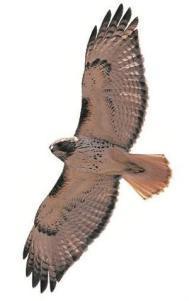
See below for a link to raptor id at Hawk Mountain
~
Hawks have been very much on my mind because I recently read Helen Macdonald’s quite wonderful memoir, H Is for Hawk, which I highly recommend.
~
Here are a few fragments of notes I wrote in my journal while I traveled home last Sunday.
what could be a hawk. but isn’t–
paper wasp nests�������� squirrel dreys (nests of food for hawks!)�������� leaf clumps���������� plastic bags[tangled in boughs]
big crows. until they fly.������������������ traffic cameras. the particular angle of them, perched (as it were) above streetlamps.
without binoculars, and in motion. not birdwatching. I scan for raptors.
frozen swamp–The Meadowlands–
snow. out of which phragmite grasses emerge, brown, russet brown. color of redtail feathers.
cranes/high tension wires. canadian geese–also in snow, feeder creeks & streams frozen, Hudson frozen, Delaware frozen.
raptor count NJ 10, PA 4. Four in 16 miles, Pennsylvania.
And yes, I composed a couple of poems during the trip.
But only one of the poems featured hawks.
~ Link to a great page for Eastern US raptor identification

February 24, 2015
Barnacles, finches’ beaks, art
Cirripedia, the barnacles, occupied Mr. Charles Darwin for many years, even though his extensive studies of the class are not what he’s famous for (except among cirripedists). The average layperson knows Darwin as the man who came up with the theory of evolution–though that is not strictly what he did, and none of his books bear that title. After the publication of On the Origin of Species and The Descent of Man, and the subsequent and ongoing controversies that followed, pretty much everything in the world could be–and has been–examined “under an evolutionary lens.”
The original “lens” involved finch beaks, pigeon-breeding, and early geology studies. It was fueled also by taxonomy, anatomy, and barnacles, by a member of the landed gentry who stayed at�� home, more or less, for 45 years after his five-year journey on the Beagle. A scholar, an “armchair naturalist” by today’s standards; a genius.
 Many people who interpreted what evolution suggested went off the deep end one way or another, which is what happens with ground-breaking ideas. Both critics and supporters misinterpreted Darwin and the implications of his work, as well, all of which means he accomplished something truly significant. Why not, therefore, examine fundamental human traits to see whether evolutionary currents can be discerned? Certainly Darwin and a few of his contemporaries speculated that altruism might have an evolutionary basis, a concept that was taken up, debated, and temporarily dismissed in the 1960s-70s; recent neurobiological and genetic studies have brought the possibility of a biological basis for kindness back into discussion (see also Damasio).
Many people who interpreted what evolution suggested went off the deep end one way or another, which is what happens with ground-breaking ideas. Both critics and supporters misinterpreted Darwin and the implications of his work, as well, all of which means he accomplished something truly significant. Why not, therefore, examine fundamental human traits to see whether evolutionary currents can be discerned? Certainly Darwin and a few of his contemporaries speculated that altruism might have an evolutionary basis, a concept that was taken up, debated, and temporarily dismissed in the 1960s-70s; recent neurobiological and genetic studies have brought the possibility of a biological basis for kindness back into discussion (see also Damasio).
There is also the question of art (and aesthetics, though taste seems more likely to be social than biological–but who knows?), which brings me to Denis Dutton’s delightful book The Art Instinct: Beauty, Pleasure, and Human Evolution.
Rather than summarize my responses to his thought-provoking and rather convincing arguments, I’m posting some quotes. These are ideas I find juicy to consider; perhaps other readers will feel similarly.
~
Wondrous aesthetic experiences are possible in the absence of a sense of larger community: the response of an individual to a beautiful landscape, for instance, …or to a recording of the Goldberg Variations heard in solitude. If the arts were intrinsically social in the way that social-cohesion theory claims, people…would prefer standing in a crowd to see a painting in a museum, rather than standing alone.
Because of sexual selection, the arts retain an incorrigible sense of being made by one individual person for another…the motives of art, as even Darwin knew, are ancient and complicated–directed toward a community perhaps, but also created to captivate an audience of one.
~
The artist…probes the content of human emotional life with an eye toward articulating, or making clear, a unique emotion, an individual feeling.
Can you imagine taking [a] pill to save the expense of concert tickets, or even the time spent in listening to a recording of the piece? The answer is very likely to be no, and the reason tells us something about the nature of artistic expression. It is not just the emotion as bare feeling we want from art, it is the individual artistic expression of emotion–how emotions are revealed in the art, through technique, structure, balance, and the blending of sounds….Yes, we want feeling from art, but not as an end for which the art is a means: with art, the means is the end itself.���������� [italics mine]
~
Extending Darwin’s original suggestion, I believe this intense interest in art as emotional expression derives from wanting to see through art into another human personality: it springs from desire for knowledge of another person….talking about art is an indirect way of talking about the inner lives of other people.
~
All of the above excerpts are from Denis Dutton, The Art Instinct, 2009.

wikispaces.com/file/view/darwins_barn...

February 15, 2015
About art (a poem)
While trying, I fear in vain, to tidy up and organize my poetry files, I came across this poem composed before 1997. Despite its flaws, I decided that rather than revise I should post it here, because it offers a narrative about how a person–shall I specify, this particular person–might come to love the wide, multicultural, historical, spiritual, experimental, transcendent “world” of art.
The library���s card catalog led me
to shelves of art books: oversized, glossy-paged,
crabbed with tiny, inarticulate commentary
about volume, form, structure,
perspective, light and shadow,
innovation and rebelliousness
and the emotive content of the line.
What did it mean? I was eleven.
I made a hagiography based upon
the beauty of still things, life arrested,
mid-gesture, on canvas, wood, stucco,
merging all my saints and artists into
a collage of stories as naive
as Rousseau���s jungle scenes–
but I believed Rousseau, and Breughel
and the intimacies of Rembrandt���s Bathsheba
and the endless processions of amazed Magi
through the narrow streets of precarious Italian towns
and Degas��� women tying up their hair
and the rich invitingness of Gauguin���s flowers
and the stark heart of Georgia O���Keeffe–
I believed I would learn to comprehend my life,
put it into perspective through
Giotto���s tiny and exquisite backgrounds,
D��rer���s precise grids, believed I would discover
an understanding of the abstract.
I wanted to be transformed through art,
the sanctity and structure of the line,
and, through them, out
of the coming confines of adolescence.
I forget so much of what I learned,
but still I possess Arles, and Athens,
the buff-colored pages of
Da Vinci���s notebooks, ink and ideas:
ink which now sprawls abstract upon the page
while I consider the emotive content
of each line–and brilliant fields of color
daubed in wild and perfect order:
a moment, a childhood, a life
saved by art.
~ �� 1997 Ann E. Michael
~
There are better poems about art (even by me); but I treasure the yearning outlook this piece suggests, and its tendency toward overstatement as well.
���

February 10, 2015
Synthesis & cigarettes
My students are too young to remember a time when smoking was permitted in public places. They’ve never seen cigarette ads in magazines. While a few of them do smoke, all of them are well aware that smoking can be dangerous. Most 18-year-olds seldom even see people smoking in movies; few celebrities flaunt a cigarette in their promotional shots anymore.

Belle Bennet, image from chuckmanphotos
And none of them are aware of the history of anti-smoking campaigns: the legal wrangling, lawsuits, longitudinal studies, public service announcements, warnings, shaming, second-hand smoke claims, discrimination against smokers, tobacco industry lobbies, or the length of time it took to convince the general public that there were genuine risks involved in the addicting and heretofore glamorous habit. Yul Brenner died of cancer in 1985, long before my students were born, so his posthumous anti-smoking public service announcement–which was big news at the time–is not even a blip on their radars. They never saw the famous “Johnny Smoke” cartoon (which terrified me as a child) featuring the frightening and authoritative voice of James Earl Jones.
Why should they know–or care–about the combined efforts of state governments (cigarette taxation), non-profits (The American Lung Association and others), medical researchers, and health advocates…and why should the fact that this process took decades matter to them? Well, maybe they could learn something from this kind of history.
Like the actions of Civil Rights protesters, who employed social advocacy for the stated purpose of changing the expectations and behaviors of citizens, “awareness campaigns” such as those created to reduce smoking offer important lessons about how long it takes to influence large communities and which methods are most likely to be successful. Cass Sunstein notes that most legislation officially becomes the law of the land after the majority of citizens are already practicing the behavior, having individually and privately decided that, say, refraining from cigarette smoking is “common sense.”
An instructor at the college where I work recently assigned his students a synthesis paper in which they were to analyze and consider a JAMA Mozaffarian, Hemenway & Ludwig article–about using public health campaign strategies in an attempt to reduce firearms deaths in the US–along with another source (or two) and then derive, from their expert sources, an approach of their own that might be a step toward decreasing the number of gun-related deaths. His students are freshmen: he did not ask them to anticipate constitutional stumbling-blocks, censorship issues, or other complexities that would–naturally–arise. He did not tell them to propose gun control at all (and only some of them did); he wanted to see what they would come up with and whether they could infer, from the JAMA article, that there are methods other than federal legislation through which social changes can be implemented.
It is a valuable assignment because his students have trouble understanding it. They show up at meetings with me and the peer tutors in writing and they complain and question and wrestle with what the professor wants. What he wants is simple: he wants them to think. He won’t judge their ideas as right or wrong as long as they show that they understand the texts and can think about the complexities.

Johnny Smoke
Here’s what I love about his assignment: students have to infer, reflect, analyze and synthesize, in the process of which it dawns on many of them that there are no easy answers; the issues are not black-&-white but depend upon perspective and social attitudes–not merely upon individual moral values, parental decrees, or civil laws. In other words: there are many other people in the world. Think about what you, the student and citizen-of-the-globe, can say to those people, respectfully, with some facts that you can convey.
It can be more than an argument. It can be a conversation, from which all of us learn more than a confirmation of our own correctness.

February 8, 2015
Awareness, openness, & … magic mushrooms?

http://michaelmhughes.com/teonanacatl-the-secret-history-of-magic-mushrooms-video-links-and-more/
In a recent New Yorker article about potential medical uses for psilocybin (“The Trip Treatment”), science, culture, and food writer Michael Pollan interviewed researchers in neuroscience, medicine, and psychology. The medical potential of psychedelic drugs is not something I can comment on from reading just one article; what intrigued me most about this piece is how these drug studies overlap with studies on cognition, metacognition, consciousness, and spirituality. The medically-controlled “tripping” that volunteers have undergone overwhelmingly resulted in some form of what we term mystical or spiritual (for lack of a scientific term) feeling.
It’s almost impossible to consider these realms of experience without questioning concepts such as “soul” or “self-awareness.” Pollan writes:
Roland Griffiths is willing to consider the challenge that the mystical experience poses to the prevailing scientific paradigm. He conceded that ���authenticity is a scientific question not yet answered��� and that all that scientists have to go by is what people tell them about their experiences. But he pointed out that the same is true for much more familiar mental phenomena.
���What about the miracle that we are conscious? Just think about that for a second, that we are aware we���re aware!���
A man after my own heart. It is amazing, a kind of miracle. And we get consciousness and metacognition without any drug intervention at all. It just springs into our beings at some point, as we create ourselves from lived events and construct speculative worlds and an understanding (though often flawed) of other minds.
Here is another fascinating result from the psilocybin studies that may make us revise our ideas of interpersonal relationships, personhood, and creating a self. Pollan writes:
A follow-up study by Katherine MacLean, a psychologist in Griffiths���s lab, found that the psilocybin experience also had a positive and lasting effect on the personality of most participants. This is a striking result, since the conventional wisdom in psychology holds that personality is usually fixed by age thirty and thereafter is unlikely to substantially change. But more than a year after their psilocybin sessions volunteers who had had the most complete mystical experiences showed significant increases in their ���openness,��� one of the five domains that psychologists look at in assessing personality traits. (The others are conscientiousness, extroversion, agreeableness, and neuroticism.) Openness, which encompasses aesthetic appreciation, imagination, and tolerance of others��� viewpoints, is a good predictor of creativity.���� [italics mine]
Openness, aesthetic appreciation, imagination, tolerance, creativity…and one researcher in neuropsychopharmacology suggests that this sort of un-boundaried openness signifies a temporary regression to an infantile state, very much as Freud hypothesized. I thought instead of Bachelard and the childhood reverie state.
Intriguing, that pharmacological work of this sort makes neuroscientists resort to citing William James and Sigmund Freud on mystical experience and the subconscious!
[Robin] Carhart-Harris believes that people suffering from other mental disorders characterized by excessively rigid patterns of thinking, such as addiction and obsessive-compulsive disorder, could benefit from psychedelics, which ���disrupt stereotyped patterns of thought and behavior.��� In his view, all these disorders are, in a sense, ailments of the ego. He also thinks that this disruption could promote more creative thinking. It may be that some brains could benefit from a little less order. ���� [italics mine]
I wonder if the aesthetic experience itself, when wholly engaged, can sometimes act like a drug on the art-viewer’s or art-maker’s being. When one reads the poem that rearranges one’s world, doesn’t it disrupt stereotyped, familiar, habitual patterns of thought? That’s what happens for me when I encounter great art of any kind. It is close to mystical.
~

February 3, 2015
Consciousness as story
Some recent questions to myself:
Reading philosophy and psychology for so many years, was I looking all along for an explanation of consciousness?
Through neurological and evolutionary science, and more philosophy and more psychology and, in addition, some anthropology, some history. And fiction. And rhetoric. Trying, perhaps, to understand the self? Through criticism, through art, through literature?
Looking carefully at art, reading literature closely: were those also endeavors to comprehend what mind is? Other minds? My own mind? Through the creative act, perhaps?
Is the ars poetica a kind of manifesto of human consciousness from an individual perspective, yet open to interpretation by other human minds? And the beautiful–what is it that even makes beauty a significant concept? Where did that come from? Evolution and the sexual drive (see Dutton riffing on Darwin)? Society? Synthesis? Ego? Inspiration? Angels?
Is every story a scaffold to consciousness? A hedge against oblivion? (Self-oblivion, the hardest navigation act there is: depression, hopelessness, loss of self-knowledge, coma).
I wonder if the stories we tell to others and to ourselves, employing memory selectively whether or not we realize it, act as a kind of (modern-day, metaphorical) Chain of Being through which we develop Theory of Mind and, beyond that, a sense not just of ego but of neurological consciousness. If stories are what make us human.
~
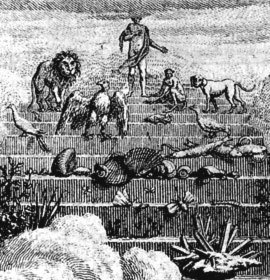
The chain of being, from Charles Bonnet, ��uvres d’histoire naturelle et de philosophie, 1779-83
[Note: I do not hold the medieval concept of a hierarchy in which Man, angels, and God stand above all other things; the stone and the plankton have as much value–likely more–than I do in the workings of the cosmos, as far as I am concerned. I post this Enlightenment-Era engraving here for metaphorical and aesthetic reasons because I take pleasure in the delightful monkey.]
~
Stories have tremendous value to human beings in ways we are still discovering; see my previous posts here, here, here, and here (among others). I keep coming across claims for the significance of story in surprising places–most recently in Dutton’s The Art Instinct and in Atul Gawande’s latest book, Being Mortal. Widely different texts, similar observations.
How is it we know who it is we are?
Possibly, in the process of inventing the story of ourselves, we become human. Perhaps the story of ourselves is fundamental to conscious “human” minds.
Speculation. But I love recalling that my children, when they were very very young, consistently made one particular demand of me: “Mama, tell me a story!”
~

January 26, 2015
Key images
I had intended to post on Denis Dutton‘s book The Art Instinct: Beauty, Pleasure, and Human Evolution; and I will (I suppose) at some point, because I enjoyed it immensely. Looking through my files, however, I found the transcripts from the initial interview Karen Jogan and��Hern��n Pereira conducted with me when they were compiling the book So Far…So Close and realized that my answers to some of their inquiries connect with my last post about poetic voice and Kunitz’s thoughts on key images. (The longer, but edited, version of the interview appears in the book).
~~
What colors or aromas remind you of your childhood?
Cinnamon toast, mown grass, onion grass (wild garlic), lily-of-the-valley, cedar-water and pine trees, the scent of a muddy river in summer, wintergreen, play-dough, school paste, steam-irons, fresh peaches, campfires, burning leaves, talcum powder, Pepto-Bismol, air-dried clothes and linens, mimosa blossoms, roses, strawberries.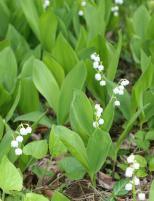
Describe yourself as a child.
I wonder from whose perspective I should attempt to answer this question. I know from others that I was considered to be shy and polite, talkative when comfortable, imaginative. I certainly felt uncomfortable among groups of people, preferring small groups of friends with whom I played make-believe. I made up stories which I told my sister and brother, and when I was old enough to write I made little children���s books that I illustrated and bound in cardboard.
My sister was my best friend, but I spent a good deal of time all by myself. When alone, I walked my dog, climbed trees, played on the swings, sketched and painted, and read books. I really was a bookworm and spent many happy hours with books and in libraries. Being alone was, and still is, deeply satisfying for me���it helps me regain creative energy.
At what moment in your life did you begin to write?
I don���t remember when I began writing. My storytelling began early, and I suppose the writing developed from there. The first story I recall writing down was about a princess; I was in second grade. I felt proud of myself, even though the story was only about three sentences long. Apparently, the poems started when I was about nine. I don���t remember writing poems then, but I recently found some that I had composed and typed up (I was fascinated by the typewriter), and my mother���s notes said I was nine when I wrote them. What I really wanted to be was an artist, but writing seemed natural to me. I started keeping a journal when I was ten…
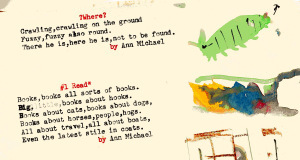
Rhyming and typing and illustrating and bookmaking– at nine years old.
What influences have been important to you?
Other writers, naturally, but first of all, visual art. From the time I was very small, I���ve loved paintings and sculptures and architecture. Church hymns and Bible verses and nursery rhymes were influential to me, as well as folk music and the lyricists of popular music when I was growing up. I am also influenced by non-fiction work, especially in the sciences, and philosophy. My early poetry influences were Donne, Shakespeare, Blake, and the King James Bible; but then I fell in love with contemporary women writers, then surrealist poets, then Latin American writers, then Asian poetry, then contemporary lyric poems���it goes on and on. It might be easier to say what I have not found particularly influential!
~~
With further reflection, I could go deeper about early images that have become, for me, “key” aspects of my writing voice…a particular landscape, the feeling of an empty nave, bees and birds, milkweed, cloud patterns, my parents singing, my little sister beside me in our shared bed, the sound of a symphony. They may not appear in my poems as such, but these images connect with me in ways I probably don’t understand. What do such keys unlock, I wonder?
~




